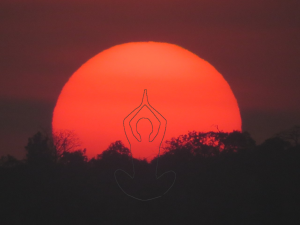Yogsadhana, Nature and Humanity

What is ‘Yog’? Types of body exercises from Indian culture? Unfortunately, or because of the limitations of today’s practices, the definition of Yog as a form of exercise with different postures just to keep our body healthy is becoming very common.
On the occasion of International Yog Day, let us take a moment and try to understand what Yog means, what ‘Sadhana’ means, and what is the relationship between Nature and Yog, Nature and ‘Yogsadhana’.
A simple question – Everyday do we live to get happiness or to get sorrow? In the book ‘Ahead To Nature’, Mr. Dilip Kulkarni has given a great example. “If you smile, the whole world will smile with you; if you cry, you will cry alone!” No one wants grief. Everyone wants happiness. Let’s see the further information in his own words …
Absolute and Eternal Happiness
How do we become aware of this happiness? Through our five organs – tongue, eyes, ears, nose and skin. We also call them sense organs. We enjoy happiness with these five different senses and the reasons for such happiness are also different. That is to say, happiness does not have to have a specific cause or object, nor does it have to have a specific sense organ to feel it! Here it is important to understand what exactly happiness is? Happiness means we forget consciousness! We undergo the supreme experience of ‘Muktavastha’ (freedom, liberation). However, both, the event and the sense organs that make us aware of it are only the means (mediums) in order to reach this state. The use of sense organ is the same as the use of a pole when jumping high (Pole vault) with a support of it. But as soon as the jump reaches the height limit, we have to come down from that stage – fast. Same happens with the happiness. We experience it for a single moment. But even if we want to get endless happiness, we don’t know how to get it. We don’t even know how to control the sense organs and the mind.
Then cannot we find ‘eternal’ happiness ever? We will! Let us see how. Basically, what happens is that the journey of the moment of bliss happens through sense organs – the mind – the intellect – (again) the mind – the action organs. At that moment our mind becomes completely calm. At the same time, the sense organs, the action organs and the intellect, all stop for a moment. We enjoy ‘Muktavastha’ to the fullest. This state is called ‘Atmasthiti’ or ‘Yogsthiti’ (self-realization). This means that the secret to reaching this ‘State of Yog’ is nothing but achieving peace of mind.
At the heart of all Indian philosophy is to calm the mind, to stabilize it, to concentrate. Reason being, only this state can give eternal, unending happiness. According to this, the process of calming the mind without material consumption is called ‘Sadhana’ and the science for it is called ‘Yog’. Sadhana can be done in different ways but the goal of each way ultimately connects to the mind, it’s control, to restraint and to balance. In short, the key is that the eternal happiness can be achieved by achieving peace of mind.
Nature and Yog
Let us now see the relationship between Nature and Yog, Nature and Sadhana, Nature and Peace of Mind, Self-realization.
Forest officer and nature-writer (in fact, nature-sage) Mr. Maruti Chitampalli have given a beautiful description of this in his book ‘Nisargavachan’. He says…
The sixth chapter of Dnyaneshwari describes Siddhabhumi (A perfect place) as follows-
‘Where one should sit to achieve satisfaction and from where one feels never to move, where there is happiness due to the presence of saints, where the mind of the atheist also desires ascetism, and where the place is so pure that Brahma (that is the above-mentioned self-realization) can be experienced.’
Those who wander in nature, those who have visited some sanctuaries have more or less the same experience.
Maruti Chitampalli used to spend hours happily observing the trees, birds, insects and their life cycle in the forest, little did he could realize at that time. People say meditation requires discipline and that needs to happen spontaneously. It does not happen forcefully. In his case, it used to happen naturally. Many ways of concentrating the mind are mentioned in the process of Yogsadhana and by observing spiders, insects, observing birds, observing the sky and wildlife, observing the rising Sun and the Venus, we do a kind of Yog by focusing our minds.
Human vs Wild Animals
Wild animals are perfect beings, but humans have to achieve perfection through Yog. The ancient sages created yogasans by observing nature, by unifying with the nature. That is why about ninety percent of the names and actions of yogasans are based on the names and behavior of animals. Simhamudra, Mayurasan, Hansasan, Kraunchasan, Bhujangasan, Makarasan, Kurmasan, Matsyasan, Shalabhasan, etc. These are not just the names of the asan’s, but they also consider the natural features of the animals. For example, the Simhamudra imitates the roar of a lion. Which makes the tongue more flexible, reducing the tendency for the throat to crack. Fruitful for singers, artists, professors. A person who practices Mayurasan regularly gets the power in the stomach to digest tough/heavy foods.
All these considerations underscore some important points. Yogasans alone does not mean Yog and Yog is not just an exercise of the body, it is a nourishment and rejuvenation of the body, mind, intellect and senses. There is an inevitable interrelationship between nature and yog and the achievement of ‘Yogsiddhi’ through it. This also means that by waging war against nature and by destroying it, we will never be able to stay happy and healthy for a long.
Hence instead of going out somewhere far away searching for the nature and the Siddhabhumi, can we work hard for flourishing of the nature and peace here itself, around us, again?
Read these books for further enlightenment: Ahead To Nature, निसर्गवाचन







